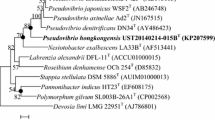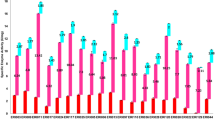Abstract
Enterococcus sp. was isolated from the midgut of silkworm against the germination ofNosema bombycis spores. Identification was based on the biochemical characteristics, 16S rDNA sequences analysis and species-specific probes ofEnterococcus spp. The isolated strains fermented sorbitol and arabinose but did not ferment raffinose.Enterococcus sp. was clustered together withEnterococcus mundtii ATCC 43188 and 100% sequence homology was found by 16S rDNA sequences BLAST analysis and constructing the phylogenetic tree. Comparison of the sequences of the 16S rDNA species-specific probes ofEnterococcus spp. with the 16S rDNA sequence of isolate revealed similar segment to the species-specific probe ofE. mundtii. So, we can make conclusion the 16S rDNA segment ofEnterococcus sp. can hybridise with species-specific probe ofE. mundtii. Enterococcus mundtii was detected for the first time in the intestine of silkworm.
Similar content being viewed by others
References
Collins M.D.John A.Farrow E.Jones D. (1986).Enterococcus mundtii. nov. Int. J. Syst. Bacteriol.36 (1): 8–12.
Dong X.Cai M. (2001). Manual of System Determinative Common Bacteriology. Science PressBeijing, pp. 370–398.
Drancourt M.Bollet C.Carlioz R., (2000). 16S ribosomal DNA sequence analysis of a large collection of environmental and clinical unidentifiable bacterial isolates. J. Clin. Microbiol.38: 3623–3630.
Facklam R.R.Collins M.D. (1989). Identification ofEnterococcus species isolated from human infections by a conventional test scheme. J. Clin. Microbiol.27: 731–734.
Higashide T.Takahashi M.Kobayashi A. (2005). Endophthalmitis caused byEnterococcus mundtii. J. Clin. Microbiol.43 (3): 1475–1476.
Holt J.G.Krieg N.R. (1994). Bergey’s Manual of Determinative Bacteriology. 9th edn.Williams & WilkinsBaltimore.
Iwano H.Ishihara R. (1989). Intracellular germination of spores of a Nosema sp. immediately after their formation in cultured cell. J. Invertebr. Pathol.57 (1): 125–127.
Janda J.M.Abbott S.L. (2002). Bacterial identification for publication: when is enough? J. Clin. Microbiol.40: 1887–1891.
Junco M.T.T.Martin M.G.Toledo M.L.P. (2001). Identification and antibiotic resistance of faecal enterococci isolated from water samples. Int. J. Hyg. Environ. Health203: 363–368.
Kaufhold A.Ferrieri P. (1991). Isolation ofEnterococcus mundtii from normally sterile body sites in two patients. J. Clin. Microbiol., 29 (5): 1075–1077.
Lysenko O. (1958). “Streptococcus bombycis”, its taxonomy and pathogenicity for silkworm caterpillars. J. Gen. Microbiol.18: 774–781.
Lu X.Hashimoto Y.Shimizu S. (1994). Taxonomical studies on enterococci isolated from the intestine of the silkworm,Bombyx mori. Journal of Sericultural Science of Japan63: 481–4875.
Lu X.Jin W.Qian Y. (1999). Distribution of the Enterococci isolated from the intestine of the silkworm,Bombyx mori. Acta Sericologica Sinica25 (3): 158–162.
Lu X.Wang F. (2002). Inhibition of cultured supernatant of Enterococci strains on germination ofNosema bombycis sporesin vitro. Acta Sericologica Sinica28 (2): 126–128.
Lu X.Huang S.Wang F. (2003). Distribution of the Enterococci isolated from intestine of the pebrine infected silkworm. Acta Sericologica Sinica29 (2): 151–156.
Manero A.Blanch A.R. (1999). Identification ofEnterococcus spp. with a biochemical key. Appl. Environ. Microbiol.65 (10): 4425–4430.
Manero A.Blanch A.R. (2002). Identification ofEnterococcus spp. based on specific hybridisation with 16S rDNA probes. J. Microbiol. Methods50 (2): 115–121.
Stackebrant E.Goodfellow M. (1991). Nucleic Acid Techniques in Bacterial Systematics. WileyEngland.
Takizawa Y.Iizuka T. (1968). The aerobic bacterial flora in the gut of larvae of the silkworm,Bombyx mori L. (I) The relation between media and the numbers of living cells. Journal of Sericultural Science of Japan37: 295–305.
Wang Y.Lu X.Mu Z. (2005). RAPD analysis of the Enterococci isolated from the silkworm,Bombyx mori. Acta Sericologica Sinica31 (1): 59–63.
Author information
Authors and Affiliations
Corresponding author
Rights and permissions
About this article
Cite this article
Fei, C., Lu, Xm., Qian, Yh. et al. Identification ofEnterococcus sp. from midgut of silkworm based on biochemical and 16S rDNA sequencing analysis. Ann. Microbiol. 56, 201–205 (2006). https://doi.org/10.1007/BF03175006
Received:
Accepted:
Issue Date:
DOI: https://doi.org/10.1007/BF03175006




